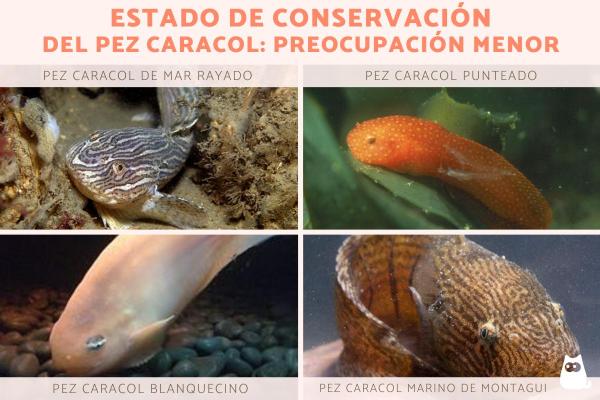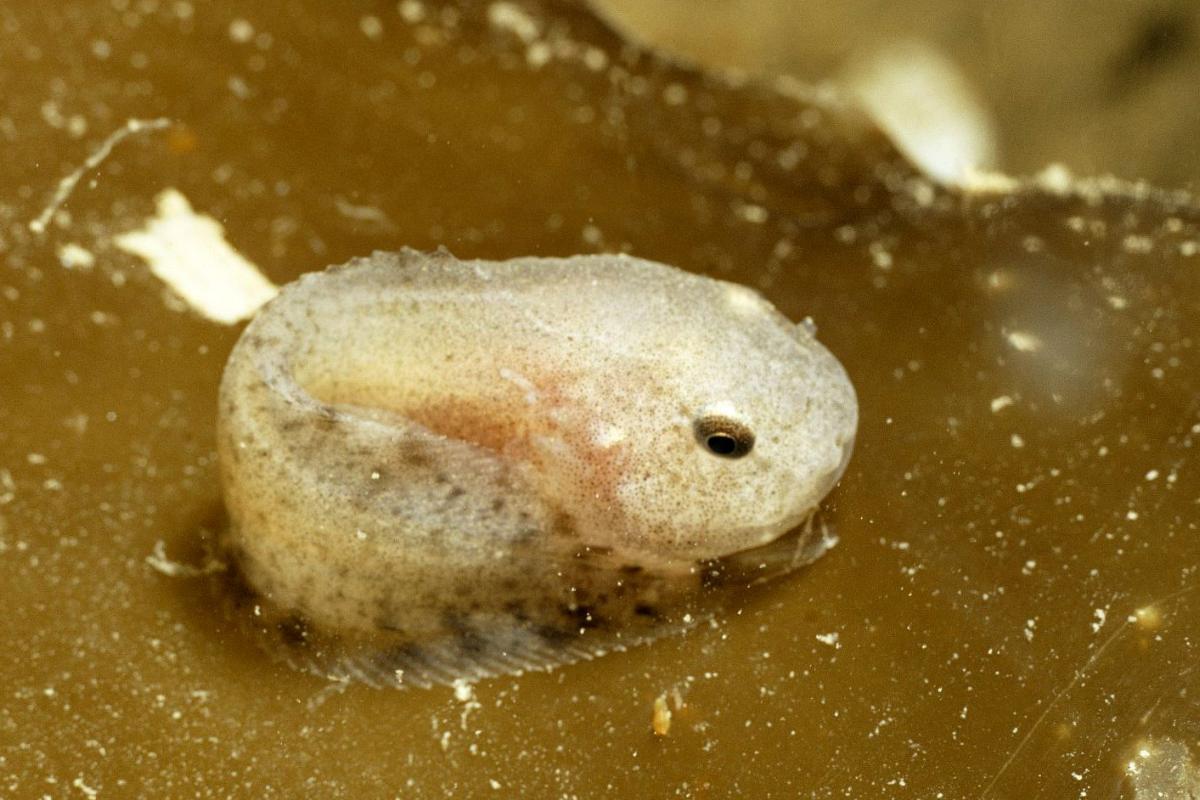Different Types of Snailfish


The snailfish belongs to the group of ray-finned fishes (Actinopterygians) and to the family of Lipariidae, generally known as snailfish or slimy fish. Within this family, 29 genera and more than 300 species have been recognized, although there is little information about many of them. Snailfish are distinguished by their tadpole-like shape and gelatinous skin.
One of the emblematic species is the Mariana snailfish ( Pseudoliparis swirei ), which was relatively recently identified in 2014, found in the famous Mariana Trench in the western Pacific Ocean. We invite you to continue reading this ExpertAnimal article, where we present interesting information about the snailfish: types and characteristics .
Characteristics of the snailfish
The snailfish is a species that has developed surprising adaptations to survive in an environment of high pressure, low temperature and scarcity of food . Its appearance, physiology and genetics present particularities that differentiate it from other deep-sea fish.
Below you can learn the main characteristics of the snailfish, also known as one of the deep sea fish :
- Genetics : Snailfish, for example, that live on the Yap and Mariana islands, have a high number of copies of a gene that is responsible for producing a compound that stabilizes proteins and allows them to withstand the intense pressure of the seabed.
- Modified senses : Due to the permanent darkness of their habitat, they have largely lost the ability to detect odors and have developed a greater number of taste receptors . This helps them locate food in an environment where food availability is limited.
- Loss of vision and pigmentation : Some species of snailfish, for example those from the Marianas, have reduced vision by losing several genes related to light detection and color recognition. In addition, the absence of a gene that regulates pigmentation production makes them completely colorless, which probably helps them go unnoticed in the gloom of the deep ocean.
- Adaptation to pressure : These fish have developed a genetic mutation that prevents cartilage calcification, which is reflected in the structure of their skulls.
- Peculiar morphology : They have elongated and slender bodies, with relatively large heads and small eyes. Their dorsal and anal fins are wide and may be fused with the caudal fin. They have a shape similar to a tadpole .
- Gelatinous, scaleless skin : The skin layer is thin, loose and gelatinous, with a high water content.
- Oral structure : Their teeth are small and blunt, designed to crush soft foods found on the sea floor.
- Specialized sensors : Deep-sea species have well-developed sensory pores on their heads, with which they detect movements and vibrations in the water.
- Locomotion : Their pectoral fins are large and are their main means of transport, although they can be fragile . In some species, these fins have a somatosensory system that allows them to detect stimuli from the environment.
- Variable size : there are small species, such as Paraliparis australis (about 5 cm long), and intermediate species such as the Mariana snailfish ( Pseudoliparis swirei ) which measures around 28 cm and other larger ones, such as Polypera simushirae , which can reach 77 cm in length and up to 21 kg in weight.
Despite their wide distribution and diversity, snailfish have no commercial importance and therefore lack studies to better understand them, since in many cases it is difficult to access their extreme habitat.
If you are interested in marine animals, don't miss this other post on " Marine animals: types and characteristics ".
Types of snailfish
The taxonomy of snailfish is as follows:
- Class: Teleostei
- Order: Scorpaeniformes
- Family: Liparidae
Now, 29 different orders have been identified. Here are some general facts about some of the snailfish orders:
- Acantholiparis : They live in the northern Pacific Ocean. Here we find the blind snailfish and the spiny snailfish.
- Allocareproctus : native to the Pacific Ocean to the north, such as the coasts of Japan. Some examples are the Cherry Snailfish and the Moustached Snailfish.
- Careproctus : Distributed throughout the Atlantic, Pacific, Arctic and Antarctic oceans. There are several species, some of which are the black snailfish and the spotted snailfish.
- Notoliparis : native to the southern Atlantic and Pacific oceans, as well as the Antarctic. Two examples are the Anton Bruun snailfish and the Kermadec snailfish.
- Pseudoliparis : They live in very deep waters of the Pacific Ocean. Two of the known species are the Mariana snailfish and the hadal snailfish.
The other genera of snailfish are:
- Crystallias
- Crystallichthys
- Edentoliparis
- Eknomoliparis
- Elassodiscus
- Eutelichthys
- Genioliparis
- Gyrinichthys
- Liparis
- Lipariscus
- Lopholiparis
- Nectoliparis
- Odontoliparis
- Osteodiscus
- Palmoliparis
- Paraliparis
- Polypera
- Praematoliparis
- Prognatholiparis
- Psednos
- Pseudonotoliparis
- Rhinoliparis
- Rhodichthys
- Squaloliparis

How deep is the snailfish found?
Most snailfish live at depths less than 4,000 meters . However, some species have been recorded in deeper areas of the ocean, outnumbering any other species, justifying the name given to them as deep-sea fishes, and reaching depths of 8,000 m .
The first species found in much deeper waters, at 7,700 m, was the hedal snailfish ( Pseudoliparis amblystomopsis ), which was found in the Japan Trench. But to the surprise of scientists, this record has been surpassed on several occasions.
In 2014, the snailfish ( Pseudoliparis swirei ) was filmed in the Mariana Trench at 8,145 metres, and in 2017, another specimen was observed at 8,178 metres. More recently, more individuals, albeit of unidentified species, have been seen above 8,300 m – an impressive depth for an animal.
Snailfishes that dominate the hadal zone, the extreme environment that extends beyond 6,000 meters depth, have developed multiple adaptations to withstand the overwhelming pressure of these depths, including:
- Highly resistant cartilage.
- Proteins that remain stable under pressure.
- Cell membranes with greater fluidity.
- Increase in the activity of transport proteins.
- Complete loss of vision and pigmentation.
Despite these adaptations, the biochemical conditions of the ocean set a limit for vertebrate life, so it is estimated that between 8,000 and 8,500 meters deep is the maximum threshold at which any fish can survive, due to the restrictions imposed by extreme pressure.
Interestingly, although hadal snailfish spend most of their lives at these extreme depths, their larvae can move to shallower waters, below 1,000 meters, allowing them to take advantage of different ocean conditions in their early life stages.
Habitat of the snailfish
The habitat of the snailfish is very varied, as they are distributed throughout the oceans of the entire world . In this sense, they develop from intertidal zones that are found at shallow depths, up to more than 8,000 m as we have mentioned in the hadal zone. In this way, this would be the animal with the widest range of any existing fish.
However, the habitat of the snailfish has a determining factor, and that is the temperature. They live only in cold waters , so those species that are in tropical or subtropical areas are strictly found at high depths. These are fish that are quite resistant to icy waters since, in fact, some species have antifreeze proteins.
What does the snailfish eat?
The snailfish, when in its larval state, has a varied diet that includes plankton, copepods of different sizes and amphipods as its main food sources, but it can be much more variable.
On the other hand, in the adult stage, the snailfish continues to have a varied diet , which is made up of:
- Gammaridos .
- Krill .
- Natantian decapods .
- Other crustaceans .
- Other fish .
An important aspect is that the size of the snailfish will determine the prey it consumes. Thus, smaller species mainly eat gammarids, while larger ones generally feed on decapods and other fish.
Reproduction of the snailfish
Reproduction of the snailfish varies from one species to another , and the reproductive modes are known mainly from those that inhabit shallower waters, which are known to spawn in specific seasons and with long intervals between each cycle.
One thing in common is that snailfish tend to lay relatively large eggs , which can reach a diameter of up to 9.4 mm . The number of eggs produced by each species depends on its biological characteristics.
Some species choose to lay their eggs on various marine substrates such as cold-water corals , algae or rocks. In certain cases, males are responsible for protecting the egg mass until it hatches.
The development of eggs after hatching varies between species; some reach maturity quickly and have a life expectancy of about one year, while others may live for more than ten years.
Since these fish inhabit an environment with poor visibility, finding a mate represents a major challenge. To overcome this difficulty, snailfish appear to employ hydrodynamic signals that are detected through their mechanosensory lateral line, a system specialized in perceiving vibrations and movements in the water.
Conservation status of the snailfish
There is no extensive assessment of the various species of snailfish. The International Union for Conservation of Nature, which is responsible for determining the conservation status, reports an assessment of only 35 species, of which only 4 are classified as Least Concern and the rest are in the Data Deficient category.
The snailfish is not of commercial interest, and only two species are reported to be affected by pollution actions, but locally. The four species classified as Least Concern are:
- Striped sea snailfish ( Liparis liparis ).
- Spotted snailfish ( Liparis punctulatus ).
- Whitish snailfish ( Careproctus albescens ) .
- Montagui sea snailfish ( Liparis montagui ).

If you want to read similar articles to Different Types of Snailfish, we recommend you visit our Facts about the animal kingdom category.
- Chernova, Natalia. (2006). "New and rare snailfishes (Liparidae, Scorpaeniformes) with the description of four new species from the Southern Hemisphere and tropical east Pacific" . Journal of Ichthyology. 46: S1 – S14. doi:10.1134/S0032945206100018. hdl:1834/17070. S2CID 10286241
- ITIS. (2024). Liparidae . Available at: https://www.itis.gov/servlet/SingleRpt/SingleRpt?search_topic=TSN&search_value=555701#null
- IUCN. (2025). The IUCN Red List of Threatened Species . Version 2024-2. Available at: https://www.iucnredlist.org/search?taxonomies=154105&searchType=species
- Walkusz, Wojciech; Paulic, Joclyn E.; Wong, Sally; Kwasniewski, Slawomir; Papst, Michael H.; Reist, James D. (2016). "Spatial distribution and diet of larval snailfishes (Liparis fabricii, Liparis gibbus, Liparis tunicatus) in the Canadian Beaufort Sea" . Oceanology. 58 (2): 117–123. https://www.sciencedirect.com/science/article/pii/S0078323415001311?via%3Dihub







